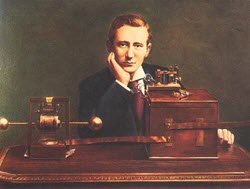
Keeping clients' computers safe and profitable for over 30 years
Home Forms About Current Newsletter subscribe
Search All Articles
Browse by Category

1903 Wireless Hack!
 While I write about many new attacks against our computers, I was amused to find out that possibly the first wireless hack was in 1903. A wireless competitor of Guglielmo Marconi, named Nevil Maskelyne, hacked a demonstration between Marconi and Sir John Ambrose Fleming at the prestigious Royal Institution in London. Maskelyne was upset that Marconi was lying about the security of his wireless transmissions. Marconi claimed his transmissions were secure because he used "syntonic tuning" of the signal. This claim was important since the government was using wireless transmissions for secret messages. Just the year before Marconi had demonstrated a transatlantic message, so his status and credibility was very high.
While I write about many new attacks against our computers, I was amused to find out that possibly the first wireless hack was in 1903. A wireless competitor of Guglielmo Marconi, named Nevil Maskelyne, hacked a demonstration between Marconi and Sir John Ambrose Fleming at the prestigious Royal Institution in London. Maskelyne was upset that Marconi was lying about the security of his wireless transmissions. Marconi claimed his transmissions were secure because he used "syntonic tuning" of the signal. This claim was important since the government was using wireless transmissions for secret messages. Just the year before Marconi had demonstrated a transatlantic message, so his status and credibility was very high.Marconi said, that the syntonic tuning security was simply not available on the small demonstration unit used by Fleming. Marconi was 300 miles away in Cornwall and sent his radio signal. Maskelyne setup in a nearby theater, blocked Marconi's transmission and rebroadcast his own message instead. It began with:
Rats rats rats
and followed with an insulting limerick about Marconi beginning with:
There was a young man from Italy, who diddled the public quite prettily ...
Needless to say, this created quite a furor and the two inventors exchanged dueling letters in the Times. Maskelyne is best known as a magician and author. Marconi, however, started a Transatlantic radio service and won a Nobel Prize with Karl Ferdinand Braun for his contributions to wireless telegraphy.
This did convince security conscious governments however, to begin using encryption with their wireless communications.
For my purposes, besides amusement, it demonstrates the 3 critical functions of encryption:
- Privacy of the transmission: I don't know whether Maskelyne could read Marconi's message, or only disrupt it.
- Authentication: Is the person on the other end who you think it is? In this case no, it was Maskelyne, not Marconi who sent the message to Fleming.
- Message Integrity: The message must be exactly what was sent, without any substitution. Here again, the security failed as the message received was not the message sent.
Further Reading:
- Article in Hackaday:
- And one from The Royal Institution, a charity connecting people with the world of science
Date: May 2017

This article is licensed under a Creative Commons Attribution-NoDerivs 3.0 Unported License.